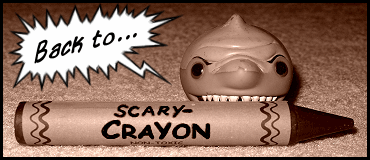As I noted in my recent review of the TMNT movie game, the Turtles have actually been back in the limelight for several years -- but even so, the release of the new CGI film seems to have triggered a new wave of nostalgia among those of us with fond childhood recollections of the green teens. Heck, I've been dutifully following the Turtles' post-Y2K exploits and didn't even like the movie, yet I've still found myself rewatching the old films and cartoon DVDs and reimmersing myself in the comics. There's another thing that I've been doing as of late, though I can't say that it's because of the movie because I've been doing it regularly for years -- playing Teenage Mutant Ninja Turtles: Manhattan Missions. Released for PCs running MS-DOS in 1991, it's probably the least known adventure featuring Leonardo, Donatello, Raphael, and Michaelangelo (post-revival spelling, baby!)... but it's also one of the best Turtles video games that's ever been released for any system. So with the recent resurgence in Turtle-mania, it's only fitting that we shed some light on this obscure gem (and, at the end, tell you where you can download a copy!) in an in-depth Scary-Crayon review.


The game kicks off with something that fans should enjoy -- a brief recreation of the Turtles' first encounter with April O'Neil and Casey Jones and a retelling of their origin story from the Mirage comics and live-action films. A few creative liberties are taken for the summary, though. As you see, the story begins with the Turtles rescuing April from a group of attackers -- but here, the attackers are clearly Foot Ninjas, as opposed to the thugs that attack her in the first movie. Additionally, whereas Casey doesn't officially team up with the Turtles in the film until he comes to their aid after Raphael is attacked, in Manhattan Missions he allies himself with them during this initial battle. Oroku Nagi and Tang Shen go unmentioned during the Turtles' origin, but that story is otherwise a faithful reiteration of their beginnings (though Splinter only shares it with them after they save April). Still, it is interesting to note that the shine of the metal canister partially obscures the text on it, such that it is all but impossible to tell whether it reads "TCRI" -- which would correspond to the Turtles' comic origin -- or "TGRI" -- which would firmly place this origin story within the film continuity. Splinter concludes his tale by stating that he trained the Turtles in the art of ninja with the explicit purpose of someday having them bring the Shredder to justice, which is more in line with his rationale in the comic book. Avenging Hamato Yoshi's death by actually killing the Shredder, however, is wholly absent from our heroes' agenda.
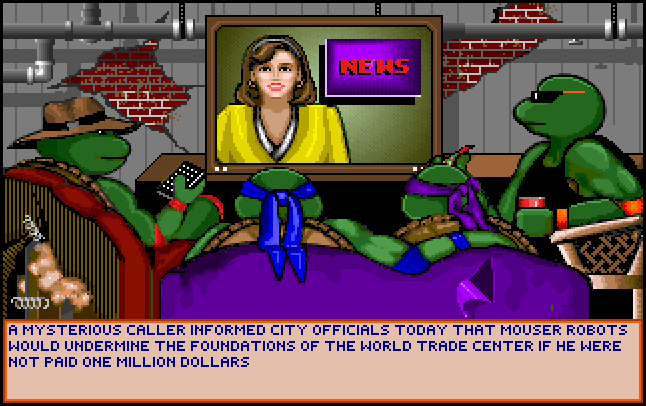
Following the introduction, we proceed to the Turtles' lair, where they watch as April delivers a message from the Shredder himself: in 48 hours, he will assume control of New York City. You'd think that that story alone would be the focus of the remainder of her broadcast, but no! Following that omninous threat, April proceeds to report on the lesser crimes taking place in New York City -- wrongs that the Turtles themselves will shortly venture forth to right. From here, players can access a menu that allows them to select from the city map, the training room, actions that allow one to examine the Turtles' condition or allow them to rest for anywhere from one to eight hours, and options for saving the game, restoring a previous one, or exiting to DOS.
We'll talk more about the city map and the training room in a bit, and the saving/loading/exiting functions are pretty self-explanatory, but the central options are related to the Turtles' health management. Suppose one of the guys loses all of his health during a particular mission. He's temporarily "dead" and unavailable for action, but resting for an hour will make him playable again -- albeit with a dangerously small amount of health. Resting for additional hours will put him in even better shape, such that (at least in the beginning) a four to five-hour rest will restore him to full health. Of course, it'll detract from the 48-hour time limit that the Turtles have to stop Shredder, but that just helps to make this adventure even more realistic. (Even though we're talking about ninjas who are also mutated turtle teens, I'll likely be using that word a lot during this review.) Examining the Turtles simply lets you see how much health they have, which can be useful for determining how long a rest you should schedule. That said, you can just as easily gauge their health by bringing up the character select menu, which is arguably ideal because it does not cause the player to lose any time from the in-game clock. However, considering that this game was designed for much older computers and that, back then, switching Turtles resulted in a loading time of at least a full minute (even if you re-selected the same one), the load-free examine option was largely preferable to this alternate method of assessment.
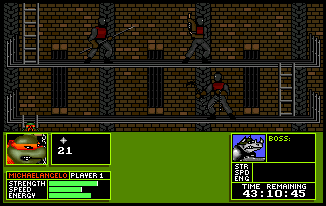
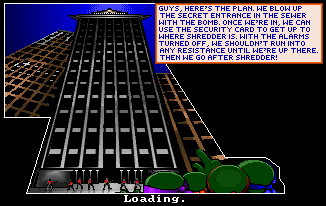
But before we discuss the meat of the game -- the actual missions -- let's touch on the graphics and sound. In keeping with the backstory, the visuals are far more reminiscent of the movie and comics than the cartoon, as the Turtles lack the large eyes and happy mouths of their animated counterparts. In fact, even though the Turtles still sport their kid-friendly identifying colors, the game's title screen is almost an exact reproduction of the second and third pages of Eastman and Laird's TMNT #1. The Foot Ninjas are similarly based on their comic book designs, though Master Splinter bears more resemblance to the film version. The Technodrome and Krang are nowhere to be found -- but just as in the "Return to New York" arc in the comics (and the 2003 cartoon), the final fight against the Shredder takes place at the summit of his skyscraper fortress. The yellow blouse notwithstanding, even April looks more like Paige Turco than the old 'toon version.
That said, while the visuals themselves don't seem terribly impressive by today's standards, it's important to remember that this game came out sixteen years ago. This was 1991, when the Nintendo Entertainment System was still the reigning console (the Super Nintendo was released in August of that year) and Windows 3.1 was still relatively new to the home PC market. And for that time period, the graphics were outstanding, with bright, crisp colors and well-animated sprites that put the washed-out and flickering NES graphics to shame. Seriously, excluding the arcade titles, Manhattan Missions was easily the best-looking TMNT game at the time. Check out the screencaps below to see how the graphics of the NES titles compare:
TEENAGE MUTANT NINJA TURTLES (NES)
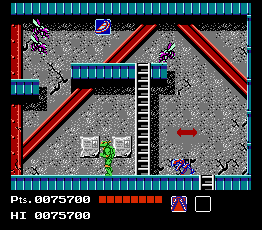
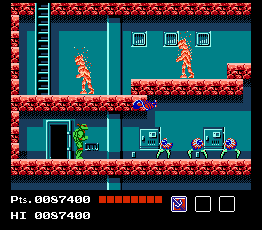
TEENAGE MUTANT NINJA TURTLES II: THE ARCADE GAME (NES)
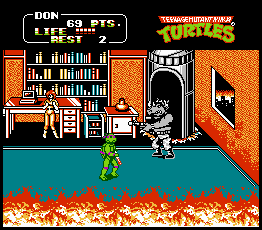
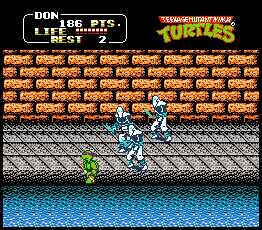
TEENAGE MUTANT NINJA TURTLES III:
THE MANHATTAN PROJECT (NES)
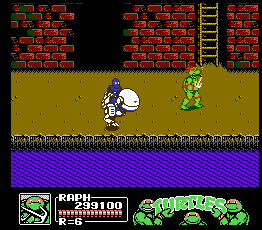
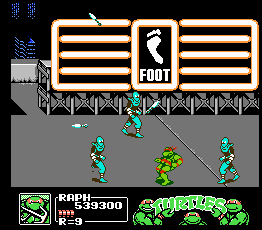
Now look at all of the other screencaps in this article -- I rest my case. In fact, TMNT III for the NES didn't come out until after Manhattan Missions was released! Suffice it to say that when I first began playing this game ages ago, the graphics were definitely absent from my very short list of complaints.
In the sound category, however, the NES games are the clear winner, with classic, energetic tunes and appropriate sound effects that easily beat out the midi score and various thumps and crunches of Manhattan Missions. That's not to say that the latter title's sound is particularly bad, though. Remember, this game was released at a time when many computers didn't even have Soundblaster cards -- my old IBM PS/2 being one of them -- and, as such, users were forced to rely upon the internal PC speaker for sound effects. And in that respect, this game was fantastic. I never even heard the in-game music until I played in DOSBox years later, but in 1991 the relatively realistic smacks of combat that issued from the PC speaker were among the best sounds that I'd heard in a PC title. Most of my games (including Street Fighter II) supplied beeps more along the lines of "kee-gee-gonk" and "bant" -- yet here, hits actually sounded like hits. I was more than pleased.
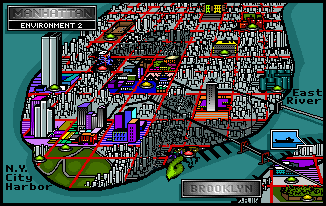
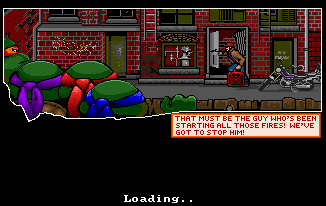
Okay, on to the city map, which is what the Turtles use to decide where they want to go. A fairly good likeness of Manhattan Island (though, as you see, some missions also take place in Brooklyn), the map is decorated with little blinking lights that identify the various hotspots and communicate their status. A yellow light indicates that the area is a trouble spot, but after you attempt and fail a mission a few times (or begin and abort a mission, which you can generally do by retreating in the same direction from whence the Turtles enter), the light will turn orange, then red, and then corresponding area of the city will darken and begin to crumble. The light turns green once you successfully complete a level -- but as you learn more about the criminal plots that you're investigating, your new information will result in the appearance of new hotspots on the map. There are a total of sixteen missions, though the player can only access up to five of them at any given time.
With the exception of the final level, in which the Turtles infiltrate Shredder's stronghold, missions in the game fall into one of five categories -- Triceratons, Arms Dealers, Environment, Ivory Smugglers, and Extortion -- that correspond to the nature of either the criminals or the criminal activities taking place. For example, whereas the Triceratons levels feature our half-shelled heroes attempting to discover what the Triceratons are planning, the Environment stages see the Turtles tracking down the villains responsible for burning down low-rent apartment buildings and dumping toxic waste into the East River. (They're not only teenagers, mutants, ninjas, and turtles -- they're also environmental activists!) Each mission is introduced by a screen that explains what's going on and discloses the Turtles' objective, which is generally to put a stop to the bad guys' immediate activities and uncover more information about their goals. Similarly, upon completing levels, players are treated to another static cutscene that helps to move the action along and explain the Turtles' next move -- which, as noted, generally leads to the unlocking of another mission on the map. Each category has three missions that the Turtles need to complete in order to squash that particular branch of crime... but just as all paths in ancient Europe led to Rome, all crimes in New York City lead to the Shredder. Only after the Turtles have completed the other fifteen missions, however, will they have accumulated the necessary tools and information to break into the Foot Clan headquarters and engage him where he lives.
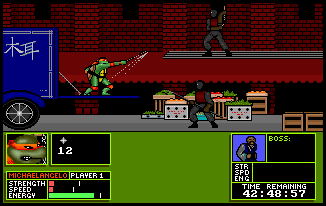
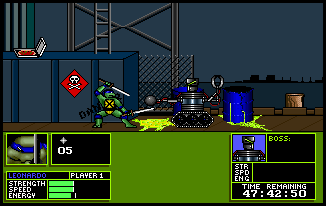
Once you choose a venue with the floating disembodied Turtle hand, the gameplay is pretty straightforward. With your Turtle(s) of choice, you progress from screen to screen -- all the while battling Foot Ninjas, Triceratons, Mousers, thugs (call them Purple Dragons if you like), robots, and assorted mutant cats and rats -- until you engage and defeat the boss at the end of the level, which generally takes between three and seven minutes to complete (though it's possible to finish missions even more quickly if you really motor through them). The game isn't a standard side-scrolling brawler, though. For one, so long as they beat the boss, our heroes don't have to kill a single "normal" enemy to succeed. Moreover, their path frequently deviates from simple left-to-right walking, as they'll have to enter doorways, windows, and sewer tunnels, climb ladders, and even locate the occasional item needed to cross a barrier. For instance, in one level, the Turtles have to enter a passage that's blocked by rushing water, so they need to locate a detached valve, find the appropriate pipe, and use the valve to turn off the water before they can proceed. At several other points, they have to find ropes in order to swing across chasms with grappling hooks. Granted, these tasks don't appear in the game often enough -- you only need to use these items in three of the sixteen levels -- but they're pretty neat where they occur. Speaking of items, players can also find shuriken for throwing at foes as well as pizzas for replenishing the Turtles' health. There's also some light platforming action, though it rarely entails more than leaping a small gap between rooftops. Missed jumps usually only result in the player dropping back down to the screen below, though it is possible to die suffer debilitating injury as a result in several levels.
Although many of the aforementioned elements are similar to those in the first TMNT game, the gameplay really diverges when it comes to the fighting, as it has several unique features that set Manhattan Missions apart from almost every other Turtles game. For one, in addition to the standard health bar, the Turtles also sport strength and speed bars that gradually deplete as battles wear on. For example, at the beginning of a fight, you'll be able to land strong blows in rapid succession, but soon your Turtle will get tired and only be able to land relatively weak blows with a more pronounced lag in between attacks. Even the bosses have these meters, which is a nice touch and helps to make the boss fights a little more balanced and -- if you will -- realistic. However, with each enemy defeated, your Turtle's endurance and energy will increase, such that Turtles who see more in-game action will become significantly more powerful than their sidelined siblings. It's a really neat feature, as it gives players more incentive to defeat enemies and make certain that all of the brothers get their share of exercise. Additionally, while defeating enemies with shuriken doesn't help to make the Turtles any stronger, their level of strength does affect the amount of damage that each shuriken does. (Whereas it initially takes two shuriken to kill even the weakest Triceratons, a maxed-out Turtle can defeat the Shredder himself with only three.) The Turtles begin their adventure with markedly different stats, but these variances become less important as the game progresses and they approach their peak physical condition.
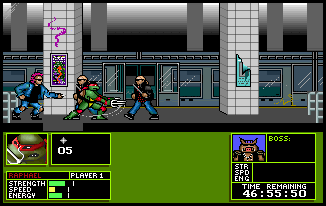
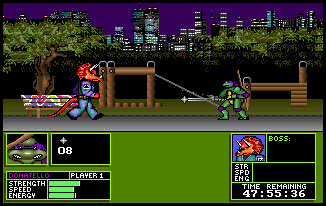
Furthermore, when they reach a certain level of strength, the Turtles gain additional attacks. While each Turtle starts out with the ability to attack once off of a single button press, they can eventually learn combinations that will enable them to attack twice (or block once and immediately follow with a counterattack) in a given "turn". Seeing as how most enemies attack in groups, it definitely comes in handy! The new attacks are also pretty exciting, at least at first, as I still recall my surprise and elation when Leo performed his standard low kick and then, in one seamless motion, used both katana to follow it up with an overhead slash. Granted, part of the reason I was so impressed was that I had no idea that the Turtles could even learn new moves (I didn't discover this until years after I began playing the game, mostly because I had previously relied excessively on shuriken to win my battles), but it's nevertheless a cool and noteworthy feature. Another neat addition: if you are killed injured in combat, Casey Jones will appear on the scene and carry your injured Turtle to safety.
Also -- though it doesn't affect the core gameplay -- the combat also deserves style points for another reason. Now, I can't say for certain, since I'm not an experienced practitioner with any of the Turtles' weapons (and because, at least by that name, Leo's "double katana" do not exist), but this is the only game that I know of in which they fight in an ostensibly realistic manner. For instance, whereas most of the games (and, to be fair, most TMNT media in general) feature Raph exclusively slashing, throwing, or otherwise using his sai in the manner of a dagger, a good amount of Raph's attacks in this game have him striking with the knuckle -- that is, the handle of the weapon. (Check out this Wikipedia entry to learn more about the sai and its usage.) Similarly, whereas most Turtles games supply the brothers with a single attack or attack combo, Manhattan Missions gives them a variety of attacks and blocks that are accomplished by holding the respective button and pressing a direction, which gives them the ability to perform five blocks and attacks (ten if you count the techniques they learn later) according to whether the player presses up, up-toward, toward, down-toward, or down (relative to the character, as there are no back attacks in this game). With their weapons drawn, the Turtles even move more slowly and deliberately than they do in their walking mode -- almost as if they are focusing on the confrontation at hand and working to anticipate their opponents' moves. In keeping with their more defensive postures, they also take less damage from enemy attacks in this mode.
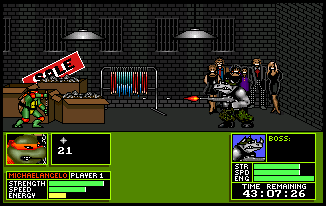
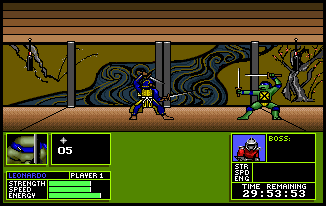
Still, as noted, the only really required fights in the game are the boss fights, as the game follows the general principle that, if you beat the boss of a given area, all criminal activity under his guidance will cease in turn. (This is illustrated by the fact that, in the areas in which you are required to engage a boss that is flanked by additional enemies, the defeat of the boss will automatically result in the deaths of those other foes.) Because several of the game's bosses have mugshots that are virtually identical in appearance to the normal enemies that you face in the game -- for example, in the cases of the Triceraton, Foot Ninja, and mobster rat bosses -- an indicator in the lower right-hand corner of the screen both displays his picture and, when you finally reach him, reveals his vital statistics. If you're hitting a guy and that energy bar isn't depleting (or the bars aren't there at all), you're attacking someone else! The bosses are an interesting amalgam of foes from the TMNT universes, too. Like in the Mirage comics, you've got your share of robots and nondescript Kingpin-esque crime bosses, but you've also got Tatsu from the movies and Bebop and Rocksteady from the cartoon. You also face off against the rather odd pairing of Baxter Stockman and Leatherhead, though our mutant alligator friend seems to have shrunk, lost his hat, and taken a liking to the color purple. (I don't remember him fighting with a club, either, but I guess he's compensating for the change in size.) There are even a fair amount of bosses that, as far as I know, are completely unique to the game, such as the aforementioned rat bosses and, in the final level, four minibosses that fight with weapons and attacks similar to those of the Turtles.

Like all of the fights in Manhattan Missions, the boss battles are straightforward, which sort of makes them lack the thrill of similar encounters in other games. For the most part, bosses don't have defined patterns or really impressive techniques; they just walk up to you and start attacking or start shooting at you from a distance. In the cases of the few bosses that are standard enemies who for whatever reason got promoted to leader class, they even have the exact same attacks. They go down about as easily as regular enemies as well, with the only difference being that you can actually see how much damage you're doing to them with each blow. That said, I've never felt let down or disappointed when facing one, and it's worth noting that a good amount of the anticipation of these encounters is lost as a result of playing on a much faster computer with hardly any loading time. See, back when I used to play this game on my 286, one could progress from screen to screen of a given level just fine -- but the boss and miniboss encounters had to be loaded. So there I was, playing at a normal rate, moving from screen to screen at a relatively fast clip and then -- suddenly -- LOADING. Oh. Crap. TIME FOR A BOSS. And then I'd spend the next minute or so staring at the screen with unblinking eyes and my fingertips at the ready, lest (and this really did happen a few times, namely against bosses like Rocksteady who fire off entire rounds with a single trigger pull) I take my attention away from the game and look back only to find Mister Jones hoisting poor Leonardo over his shoulder.
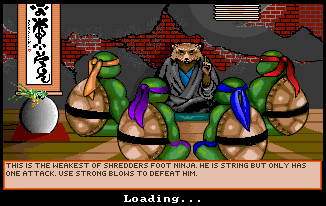
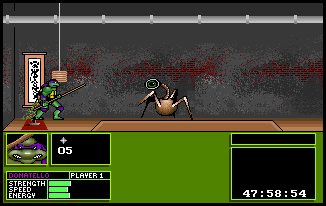
And then, in addition to the missions, you've got the training room, where the Turtles can select an enemy from their combat simulator and battle against him in their dojo. Unlike the actual foes to be found in the levels, simulated enemies can't harm the Turtles at all -- yet the Turtles can still increase their health and endurance by defeating them. As such, although the simulator doesn't allow players to fight every enemy in the game, the training room is a great way to safely identify the various strengths and weaknesses of foes while receiving the benefits of exercise. It's pretty much like a real training room! Master Splinter will also give the Turtles various tips (replete with typos) about how to defeat the enemies, though they generally consist of useless advice like "keep your distance" and "use strong blows to defeat him" -- as if one would otherwise have attempted to beat them by moving in really close and swiping at them with feathers! Alas, sometimes Splinter's info seems a bit misguided, as his reports on enemies haven't always meshed with my experience. For example, he informs the Turtles that the nunchaku-wielding Foot Ninja is the strongest of the Shredder's forces, yet I've always found the spear-carrying Foot Ninja to be the single nastiest enemy in the entire game. Forget about the other regular enemies -- not even the Shredder himself can match that Foot Ninja's skill.
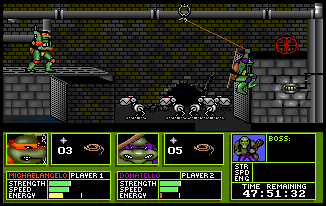
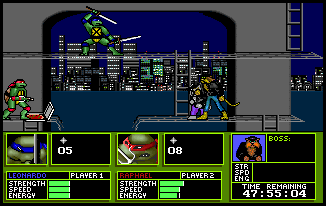
And you know what else? The game even supports two-player simultaneous action! Granted, a buddy's help isn't exactly necessary to beat the game, but -- considering that enemies often attack in groups of two and three -- the multiplayer element can certainly help to even the score in combat situations. Also, given that the levels consist of multiple screens that change when one player moves to the next, having two players on hand can effectively make it easier to complete certain tasks. For example, in the above-left image, note that Don is using the rope to swing across the Mouser-filled pit and reach the valve. Under normal circumstances, after retrieving it, he'd have to drop down into the pit and either fight the Mousers or beat a very hasty retreat via the downward path -- both of which would be difficult to do without getting bitten once and "dying" as a result. With Mike over there, though, Don can pick up the valve and simply wait until Mike exits the left side of the screen, whereupon both Mike and Don will appear on the right of the adjacent screen. Similarly, in the above-right image, Raph would be forced to fight the mutant cats to get to the ladder on the upper level, whereas Leo would have to deal with them to get to the pizza and the ladder below it. But with two players, Leo can either climb up or Raph can climb down (or step exit left and then reenter the screen, if Leo wanted the pizza) to transport them both to their desired location. Again, a single player could certainly manage -- respectively, I would swap Don out to ensure his survival and kill the cats for the endurance boost -- but the presence of a second player adds a cooperative strategic element that makes the adventure even more engaging.
Still, even if you haven't got a buddy around to accompany you through the mean streets of New York City, Manhattan Missions is definitely worth a playthrough (at least!) for Turtles fans and folks who enjoy retro games. Gamers today may not love it quite as much as I do -- and therefore may not still play it regularly even sixteen years later -- but I have a lot of fond memories and pleasant emotive recollections wrapped up in this game. I never owned a NES, so this was the first TMNT game that I really had the chance to get into. (I had the first game for the PC as well, but it was so friggin' hard that I never even made it to Rocksteady back then.) A classmate of mine would frequently come over after school let out, and we spent many afternoons sitting shoulder-to-shoulder together at the keyboard in keeping with the two-player keyboard controls. That helped to make the game even more enjoyable, as we bonded not only during the actual gameplay, but also while the game loaded. We discussed potential strategy, tried to anticipate the kinds of enemies that the levels would contain, and called dibs on the unselected Turtles in case one of us fell in battle. Even after we'd beaten it multiple times, I continued to play by myself for a time, and I liked the levels so much that I even drew up my own little blueprints of additional levels that might be included in a sequel. I eventually stopped playing it in favor of focusing on other games, but Manhattan Missions has always been among the first programs that I've installed on the new computers that I've gotten since. I really, really like this game.
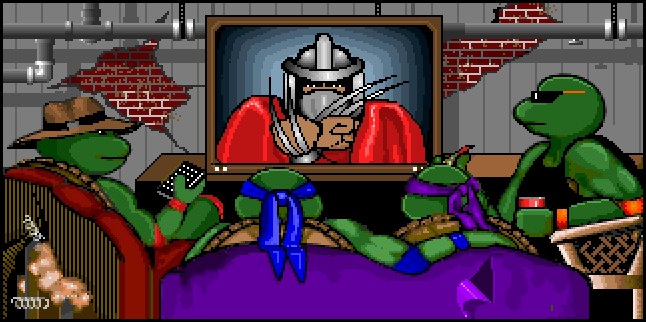
Heck, I've actually come to appreciate it even more over the years. I never realized how much I liked Konami's prior intermixing of the various TMNT universes until the releases of the more recent games, but the main draws for me are still the fun (if simplistic) gameplay and the way that the overall product comes together. Granted, it's probably the easiest Turtles game ever. The missions aren't all that challenging, and one has 48 hours to beat the game -- which is way more than enough time, as one can fairly easily complete it in less than an hour on the in-game clock. It's also pretty short. Back in 1991, the loading times lengthened the game to the point where playing through it in a single afternoon was fairly unlikely (hence the saving and loading), and -- even if one did -- it wasn't that disappointing because most console-style games back then could be beaten within a few hours. Yet nowadays, playing in DOSBox on a comparatively fast machine, it's entirely possible for a speed-minded player to clear the entire game within a literal hour as well.
That said, challenge and length aren't what make Manhattan Missions great. What's great about it is that you can rush head on into combat and plow through the game a la Raphael, or you can play things like Leonardo by training the guys at length in order to help them reach their maximum potential. You can tackle missions in (almost) any order. You can avoid enemies, or, seeing as how many of them are located on screens and in areas that don't even need to be crossed to reach the end, you can go out of your way to hunt them all down and really take out the trash. And if you do happen to take a beating and lose one of the guys in the process -- or want to be lazy like Michaelangelo and rest for no reason at all -- you can have the Turtles take a few hours to replenish their energy and return to the fray well-rested and ready for action. You can even sit back, relax, and watch April on the tube! Even though the core gameplay still primarily involves walking around and killing enemies, the training and health management features make this the closest to a bona fide role-playing game that the Turtles have ever seen. Playing this game is comparable to watching a TMNT story arc unfold, except you exercise a great deal of control over just how the Turtles go about taking down the Shredder and restoring order to the city. And that is why Manhattan Missions remains my favorite TMNT game to this day.
You know you wanna play Teenage Mutant Ninja Turtles: Manhattan Missions -- so pop on over to the Home of the Underdogs to download it! Remember, you'll probably need DOSBox to play... and the D-Fend frontend makes things a little easier, too.
